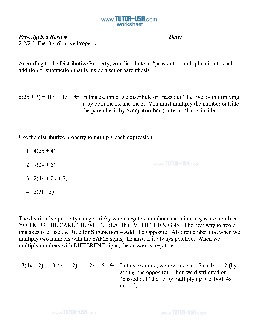The Distributive Property - Combining Like Terms - Expressions
Worksheet (Pre-Algebra)

The Distributive Property - Combining Like Terms - Expressions Worksheet
Lesson:
Subject:
Number of Problems:
Pages:
Answer Key:
Samples:
Pre-Algebra Review
The Distributive Property
According to the Distributive Property, you distribute or “pass out” a multiplication to each addition or subtraction that is inside a set of parenthesis.
5(2x + 3) = 10x + 15
In this example, we distribute or “pass out” the five by multiplying it by both the 2x and the 3. You must multiply the number outside the parenthesis by every number (or term) that is inside. Use the distributive property to multiply each expression:
1. 4(2x + 4) = ____________________
2. 7(3y + 5) = ____________________
3. 2(4y + 2x + 3) = ________________
4. 2(3t – 3) = ____________________
The distributive property can get tricky when negative numbers and minus signs are involved.
The best way to avoid mistakes is to use the Rule for Subtraction – Add The Opposite. Also remember that when we multiply two numbers with the SAME signs, the answer is always positive. When we multiply numbers with DIFFERENT signs, the answer is negative.
–3(4x – 2) = –3(4x + –2) = –12x + 6.
In this example, we rewrote 4x – 2 as 4x + –2 (by adding the opposite). Then we distributed or “passed out” the –3 by multiplying it to both 4x and –2.
Use the distributive property to multiply each expression:
5. –2(3x – 5) = __________________
6. (5b – 2)(–4) = __________________
Simplifying Expressions by Combining Like Terms
Download Worksheet
All Worksheets © Tutor-USA. All Rights Reserved.

